Trawlers, Standby Ships, Supply Ships, Wind Farm Service Operation Vessels
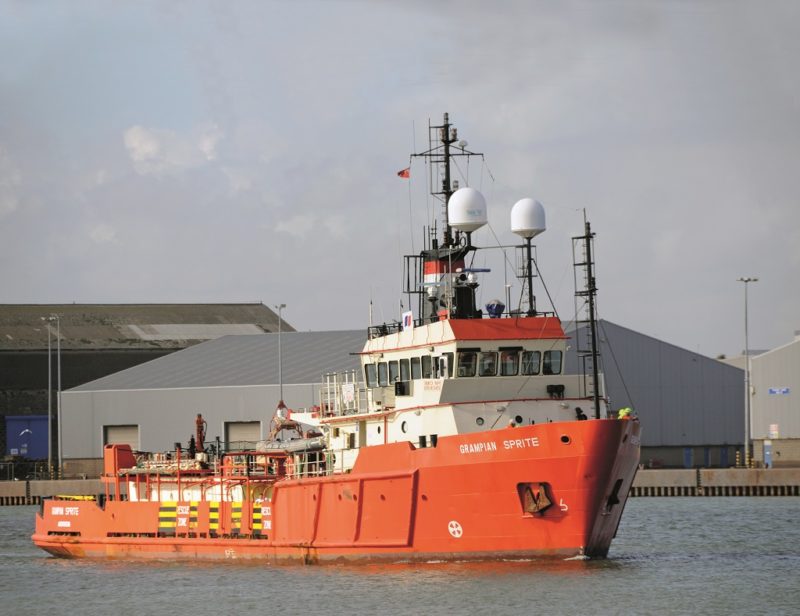
The fishing history of George Craig goes back at least a century as he was operating the steam trawler Taurus of 128 grt during World War I. She had been built back in 1883 by Earle’s Shipbuilding & Engineering Co. Ltd. at Hull, and was sunk on 14th July 1917 by a mine laid by U-71 to the East of the Shetland Islands with the loss of all of her crew of nine. He then owned two steam trawlers in 1928 from his home at 108, Victoria Road in Torry in the south district of Aberdeen in Cecil Rhodes of 112 grt built back in 1891, and Craig-an-Eran of 202 grt built in 1906. The latter was built as Loch Earn and registered under the Red Star Steam Fishing Co. Ltd. on 15th May 1906 at 164 Market Street in Aberdeen by Harry A. Holmes. She served as a minesweeper during World War I and was renamed George Stroud in 1917 by Stroud’s Steam Fishing Co. Ltd. at the same address in Aberdeen. She was purchased on 11th July 1928 and renamed Craig-an-Eran by George Craig. She was named after a horse that won the 2,000 guineas in 1921 owned by 2nd Viscount Waldorf Astor. She stranded on 18th March 1938 at Broadhaven to north of Wick, and was towed into Wick and later repaired by John Lewis & Sons Ltd., Aberdeen. She was sold to Herman Westerborg to fish out of Milford Haven in 1939 and was attacked by bombs and gunfire on 8th January 1942 off the Old Head of Kinsale. She fished for another ten years until broken up in 1952. During World War II, trawler skipper George Craig had his own expanding fishing company operating three coal fired, steam powered, deep sea trawlers out of Aberdeen.
The fishing history of the North Star Fishing Co. Ltd. of Aberdeen goes back to the first screw propelled trawler built in Aberdeen in 1883 as North Star by John Duthie for W. Pyper & Company of Aberdeen. She had dimensions of length 101.4 feet, moulded beam of 19.0 feet, and depth of 14.2 feet. She landed £46,951 of wet fish at Aberdeen during her first seven years of fishing, and was sold to the North Star Fishing Co. Ltd. (John Alexander Harrow, manager) in 1901. She later fished from South Wales and then became the Tees tug Primrose in 1903 and was broken up in December, 1914. North Star (2) of 188 grt was built in 1907 by Hall, Russell & Co. Ltd. for the North Star Fishing Co. Ltd. (John Alexander Harrow, manager). She was requisitioned on the outbreak of World War I and converted to a minesweeper, and was returned to her owners in 1919. She was sold in 1923 to A. Christie of Aberdeen, and then fished from Granton in 1935 until broken up a year later.
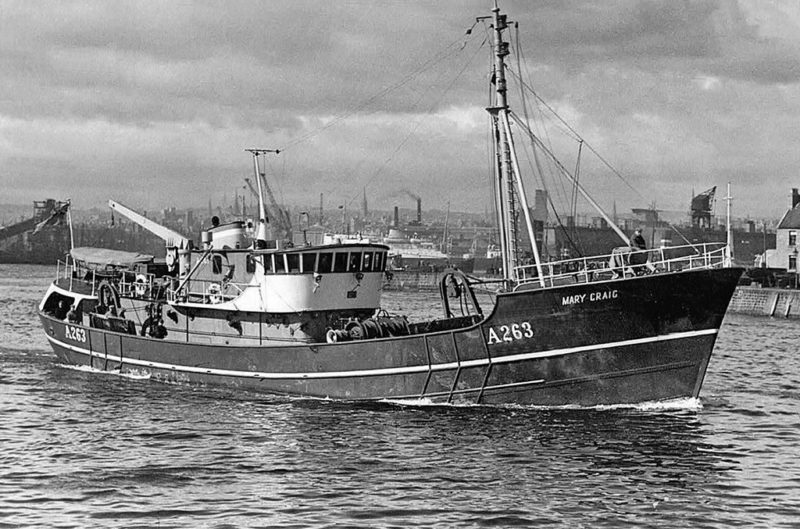
POST-WORLD WAR II TRAWLING
The fleet expanded in the post-war years, with the combined fleet of George Craig and the North Star Fishing Co. Ltd. of Aberdeen in 1950 standing at a dozen trawlers in Avondow, Avonglen, Avonriver, Avonview, Avonwater, Controller, John Morrison, Kings Court, River Ness, Strathdevon, Strathglass and Sunlight. The North Star Fishing Co. Ltd. was taken over on 30th April 1962 by George Craig & Sons Ltd. of Aberdeen to fish for cod with a bigger fleet. A fleet of twenty deep sea trawlers was being operated in the 1960s and early 1970s named Mary Craig, George Craig, Cevic, Coastal Empress, Grampian Cairn, Grampian Crest, Grampian Eagle, Grampian Glen, Grampian Heather, Grampian Hill, Grampian Monarch, Admiral Drake, Admiral Frobisher, Admiral Jellicoe, Scottish King, Scottish Princess, Scottish Queen, Avonview, Avonriver and Parkroyd, the latter built in 1960 and purchased in 1969 from Near Water Trawlers of Grimsby. The fleet had black hulls with a white line and red boot topping, and grey funnels with a thin black top separated by red over white bands. The trio of trawlers with Scottish names were owned by Scottish Trawlers Ltd. and also carried a Scottish thistle on their Craig funnel colours.
Today, the fourth generation of the Craig family manage one of the most successful businesses in North East Scotland with bases in Aberdeen and around the world in Houston, Cape Town, Ghana and Poland with a turnover of £110 million. Douglas Craig and his daughter Samantha lead the worldwide management team.
Grampian Glen of 127 grt was completed in 1975 by Scott Company of Bowling, but had a very short life in the North Star Fishing Co. Ltd. fleet of only three years as she sank on 5th October 1978 after the failure of her bilge pump after rapid flooding of the hull when fishing 150 miles from Aberdeen, with the unfortunate loss of six of her eight crew members. The trawler George Craig of 197 grt was launched on 26th August 1957 at Peterhead by Livingston & Co. Ltd. as John Watterston for the Inch Fishing Co. Ltd. However, the owners failed to make the final payments on the vessel, and she was then purchased by George Craig & Sons Ltd. and renamed. She sank in Aberdeen harbour on New Year’s Day in 1972 when the trawler Strathallan became jammed under the quay wall and sank taking George Craig with her. She was salvaged and repaired and was sold in 1972 for fishing from Peterhead and later from Haverfordwest as a ‘long line’ trawler. She was fishing from Spanish ports in 2005 and returned to fish from Ullapool in 2008 after a long fishing career of over fifty years. The best daily catches of cod made by the ‘Grampian’ fleet of George Craig were of 158 hundredweight or almost eight tons!
When the distant water trawling fleet began to suffer huge problems from low quotas, overfishing and international legislation, the decision was taken in 1978 to convert some of the fleet into oil rig standby vessels as rig safety regulations required one safety vessel to be on hand for rescue for every oil rig and platform working in the North Sea oilfields. Trawler owners such as Richard Irvin & Sons Ltd. of Aberdeen and North Shields, British United Trawlers Group, Colne Trawlers, Cam Trawlers, Wyre Trawlers of Fleetwood, Boston Putford of Lowestoft and others did also convert some of their fleets to standby vessels, and some were sold to the Craig Group, with five joining at Aberdeen in 1978 and taking ‘Grampian’ names. The ‘Grampian’ fleet of George Craig & Sons Ltd. in 1980 was composed of fourteen trawlers and standby ships named Grampian Castle, Grampian Chieftain, Grampian Explorer, Grampian Falcon, Grampian Heather, Grampian Hunter, Grampian King, Grampian Prince, Grampian Queen, Grampian Ranger, Grampian River, Grampian Star, Grampian Venture, Grampian Warrior.
Oil rig standby vessels were required to be on duty near the rig on a 24/7 basis, with engines running or drifting for short periods, and their former large fish holds converted into accommodation space for the rig crews evacuated in times of emergency. The trawler crews, who faced redundancy and were used to a life of extreme hardship with thirty days at sea and only five in port, were thus given a reprieve working on the rig standby vessels after being sent on First Aid and Rescue Boat Handling courses. They were saved from the most dangerous and wettest part of fishing of hauling nets in rough weather, and sorting and gutting the catch.

Richard Irvin & Sons Ltd. of Aberdeen and North Shields had the same sized trawler fleet of twenty trawlers in the 1960s and early 1970s as George Craig & Sons Ltd. and the North Star Fishing Co. Ltd. of Aberdeen. Richard Irvin had been born in North Shields in 1853 and began fishing there in 1875 with an Aberdeen branch opened in 1887. Converted paddle tugs were used at first and followed the example set by William Purdy, who also had a large trawler fleet at North Shields in Purdy Trawlers Ltd. The firm became Richard Irvin & Sons Ltd. from 1885 with four sons joining the business in Richard Irvin Junior, John Hannel Irvin, George Driver Irvin, and Thomas W. Irvin. The Irvin family established the Shields Engineering Co. Ltd. with a construction and repair yard with a graving dry dock just upstream from North Shields Fish Quay. A large fleet of thirty six trawlers with a nomenclature of ‘Ben’ names after Scottish mountains, as well as a large herring drifter fleet were owned by 1932. The fleet included Ben Ardna, Ben Arthur, Ben Barvas, Ben Bhrackie, Ben Breac, Ben Chourn, Ben Earn, Ben Gairn, Ben Glamair, Ben Glas, Ben Gulvain, Ben Heilem, Ben Lora, Ben Meidie, Ben Rossal, Ben Roy, Ben Screel, Ben Strome, Ben Urie and Ben Vurie, as well as Polar Prince of 194 grt and built in 1915, and a particular favourite of mine as she was still trawling from North Shields in the 1950s. The Irvin fleet had black hulls with red boot topping, and black funnels with two thin red bands.
George Driver Irvin was sent in 1902 to Cape Town to set up the African Fishing and Trading Co. Ltd., and teamed up with Carl Ossian Johnson to form the management firm of Irvin & Johnson in December 1910. A very large South African trawler fleet of forty steam trawlers was operated from Cape Town in 1932, and 43 motor trawlers of up to 800 grt were being operated from Cape Town in the early 1950s. This, when combined with the twenty seven trawlers owned by Richard Irvin & Sons Ltd. at Aberdeen and North Shields in 1950, gave a combined total of 70 (43 + 27) trawlers in 1950, fishing from the ports of Aberdeen, North Shields and Cape Town for one family. The Irvin family were operating twenty trawlers at Aberdeen and North Shields in 1970, and had formed a very considerable post – war fishing enterprise. The latter fleet working in the North Sea and around the Shetland Islands in 1970 comprised Ben Asdale, Ben Arthur, Ben Bhrackie, Ben Chourn, Ben Dearg, Ben Edra, Ben Gairn, Ben Glas, Ben Gulviain, Ben Heilem, Ben Idris, Ben Lora, Ben Loyal, Ben Lui, Ben Meidie, Ben Screel, Ben Strome, Ben Tarbert, Ben Vurie and Ben Wyvis.
The big Irvin & Johnson Ltd. trawler fleet at Cape Town in the early 1970s had mostly African flower names in Afrikaner, Aloe, Aster, Anemone, Azalea, Armana, Arum, Boston Typhoon, Boston Weelsby, Begonia, Captain Inman, Crassula, Dahlia, Dorissimo, Erica, Godetia, Hawthorn, Hibiscus, Iris, Ixia, Lobelia, Larkspur, Linaria, Lupin, Nerine, Ooskus, Orotave, Proteus, Prima, Princess Elizabeth, Princess Royal, Pionier 1, Pionier 2, Pionier 3, Pionier 4, Rochea, Ross Jupiter, Salvia, Stevia, Verbenna, Verkenner I and Verkenner II.
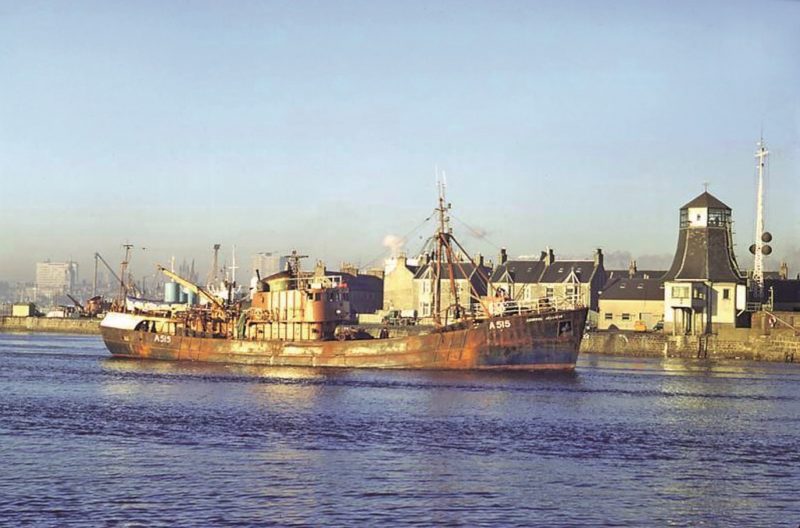
OIL RIG STANDBY SHIPS (ORSS)
The North Sea oil industry on the Tees moved into a higher gear in 1965 with the import of crude oil by shuttle tankers and by a long 150 mile length of pipeline onto land at the Phillips refinery in North Tees from the Ekofisk oilfield in the Norwegian sector of the North Sea. The BP drilling rig Sea Gem also was towed out from her building berth at South Bank yard of Smith’s Dock Co. Ltd. on the Tees in May 1965, with her ten retractable legs and a drilling derrick, bound to prospect for an oil find 40 miles off the Humber estuary. Oil in huge quantities was found on 17th September 1965 to begin the British offshore oil industry in the British sector of the North Sea.
However, three months later Sea Gem suffered a catastrophic loss of stability on 27th December 1965 when she was being moved to another drill location a couple of miles away with two legs collapsed and the rig was tipped over at a steep angle. Thirteen rig crew members died in the tragedy, with the remainder rescued by helicopter and the United Baltic Company (UBC) vessel Baltrover. The Labour Government of the day then passed the Mineral Workings Act, which required that all oil rigs and platforms have a dedicated standby vessel near at hand in case of a similar tragedy, as well as an Offshore Installation Manager (OIM) on duty at all times on the rig.
The oil industry at Aberdeen began to get into its stride in 1970 with many oil rigs prospecting for oil to the north east of the trawler port, as well as production platforms sending crude oil by pipeline to the mainland near Peterhead. The ‘granite city’ of Aberdeen began to be home for a large number of oil industry companies providing all manner of services including flying rig crews by helicopter from Aberdeen Airport to the rough weather locations of the rigs, and from Sperry gyroscopes to Barbour oilskins. Oil Rig Supply vessels (ORSV) and Oil Rig Standby Ships (ORSS) crowded into the tiny harbour of Aberdeen to jostle with each other and the trawlers and the fitting out quay of the shipyard of Hall, Russell & Co. Ltd.
The North Star Shipping (Aberdeen) Co. Ltd. of the George Craig Group had a large number of ORSS standby vessels in service in the North area of the North Sea from 1978 to 1991 and operating from the North Esplanade East in Aberdeen. This including the following:-
- Grampian Castle built in 1956 as Boston Seafoam
- Grampian Loch built in 1956 as Red Rose
- Grampian Star built in 1956 as Hawfinch
- Grampian Falcon built in 1953 as Idena
- Grampian Admiral the former Admiral Nelson
- Grampian River the former Admiral Jellicoe
- Grampian Prince, the former Admiral Drake
- Grampian Petrel, the former Seaward Petrel built in 1959
- Grampian Quest, the former Seaward Quest built in 1959
- Grampian Defender the former Boston Defender
- Grampian King the former Scottish King built in 1959
- Grampian Princess the former Lindenlea
- Grampian Explorer the former Aberdeen Explorer of 425 grt built in 1965
- Grampian Dawn and Grampian Scott, the former Ben Strome and Ben Meidie of Richard Irvin & Sons Ltd.
- Mary Craig built for George Scott & Sons Ltd. in 1959
- Renfrew built in 1971
Three new ORSS standby vessels recently built for Standby Shipping Ltd. were purchased by North Star Shipping between 1983 and 1986 as Grampian Pioneer of 501 grt, Grampian Pride of 501 grt and Grampian Protector of 573 grt. On 26th July 1989, the North Star Fishing Co. Ltd. changed its name to North Star Shipping (Aberdeen) Co. Ltd. By that time, many more trawlers had joined the ranks of the North Star fleet in Grampian Concord, Grampian Eagle, Grampian Endeavour, Grampian Forest, Grampian Freedom, Grampian Harrier, Grampian Hawk, Grampian Kestrel, Grampian Monarch, Grampian Osprey, Grampian Queen, Grampian Quest, Grampian Ranger, Grampian Rose, Grampian Shield, Grampian Sword, Grampian Viking and Grampian Warrior to give a big fleet of thirty standby and rescue ships by 1990.
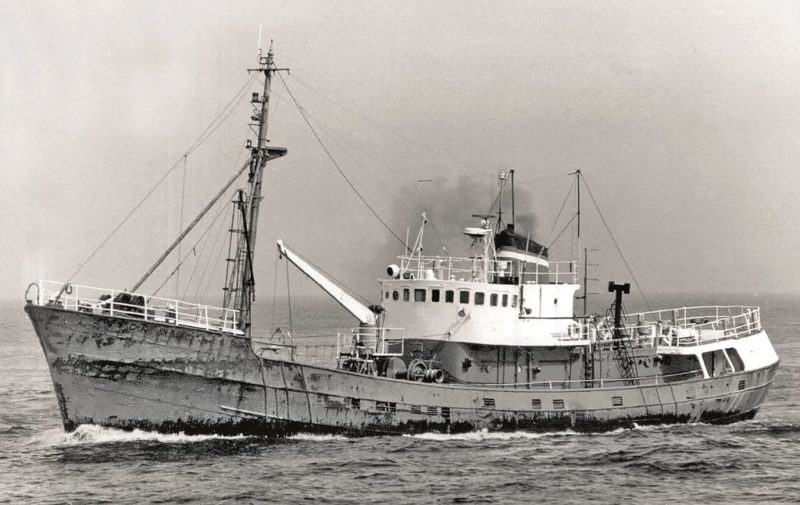
However, mostly all of the U.K. fleet of ORSS ships, 162 out of 187, were former fishing trawlers in 1988 with hand steering, rudimentary communication systems, and no form of standby main power engines connected to a single screw in the event of an engine breakdown and no manoeuvring ability to carry out a crew rescue in an emergency.
All of this standby fleet of mostly elderly former fishing trawlers came to the end of their usefulness after the swingeing recommendations of the Court of Enquiry into the loss of the Piper Alpha platform disaster on 6th July 1988, when it exploded into a huge fireball, which consumed her wooden decking, and cost the high price of 167 lives and a financial loss of £2 billion. This was the biggest offshore oil disaster in the world and affected over 10% of U.K. oil production. Piper Alpha was operating 120 miles north east of Aberdeen for Occidental Petroleum (Caledonia) Ltd., a subsidiary of CONOCO of the U.S.A. It began oil production in 1976 and was converted to add gas production ten years later. The control room of the platform was badly damaged in the first explosions, but fortunately the control room operator survived and gave valuable evidence to the Court of Enquiry. The radio room was rendered useless and all communications were lost almost at once.
The Cullen Report on the Court of Enquiry was thorough when it reported in 1991. It uncovered all of the sequence of events on that terrible night, but also the complex path leading up to it, the early warnings and missed opportunities that might have prevented a tragedy and the loss of 167 lives. The main recommendations of the Cullen Report were:-
- Management of change particularly regarding design changes for gas export to the mainland.
- Personal safety over process safety, with fire water pumps on manual start to protect workers and divers.
- Wholly inadequate isolation and permit pump maintenance start-ups before maintenance operations began.
- Slow handover of crews from shifts and inadequate transfer of information between them.
- Complacent safety culture operation of the ORSS Silver Pit, an elderly converted trawler standing by Piper Alpha, and her serious manoeuvring difficulties and temperamental bow thruster that failed completely after only five minutes in use. This was due to the inadequacy of the regulations under which ORSS vessels were equipped and operated.
- Very slow emergency response and evacuation with only a ‘token response’ from the ORSS in picking up the surviving men that were drowning in the sea.
The biggest oil disaster in the world up to that date stemmed from the fact that permission was granted to export gas by pipeline from the platform instead of it being flared off. The gas condensate pump B triggered at 2145 hours, gas alarms activated, the first stage gas compressors tripped with a gigantic explosion caused by gas ripped through the entire platform at 2200 hours. No oil platforms have since been built with wooden decking, steel decking being absolutely essential on all oil rigs and platforms.

The dreadful loss of life on the huge fireball of Piper Alpha forced long overdue extensive changes to the standby ship regulations and codes. This at a stroke, rendered 162 out of 187 ORSS vessels completely redundant, with the only hope being a possible return to fishing if their age and fishing quotas allowed. This did not happen for the obvious reason of their age and the decimation of allowed fishing periods under new revised British fishing quotas, and their total inadequacy for the standby role and the rescue and saving of life roles. New dedicated ‘Rescue Zones’ were now clearly painted and indicated with precise limits on hulls to where it was easier for men to be hauled from the sea.
North Star Shipping (Aberdeen) Co. Ltd., as with all of the ORSS vessel owners, had to re-evaluate their thinking on these roles, and ten second hand ORSV vessels were purchased from Stirling Shipping Ltd. and Standby Shipping Ltd. and re-equipped for standby safety use in the light of the new stringent regulations. Grampian Eagle (ex Stirling Eagle), Grampian Haven (ex Stirling Merlin), Grampian Sprite (ex Stirling Sprite), Grampian Sword (ex Stirling Sword), Grampian Venture (ex Stirling Puck), Grampian Pioneer (ex Standby Pioneer), Grampian Pride (ex Standby Pride), Grampian Protector (ex Standby Protector), Grampian Crusader (ex Hamilton Piper), and Grampian Osprey (ex Sea Service Osprey).
By 1998, the North Star Shipping (Aberdeen) Co. Ltd. fleet was composed of thirty vessels, with twenty six ORSS Standby Safety vessels, three Oil Rig Supply Vessels (ORSV), and one powerful anchor handling tug (AXHT) in Grampian Prince of 1,294 grt and built in 1981 for the Emergency Towing role of vessels in trouble, particularly tankers, that drifted aground and caused enormous pollution and loss of habitat and wildlife e.g. the tanker Braer that stranded in January 1993 at Sumburgh Head on the southern tip of Shetland on a voyage from Mongstad in Norway to the U.S.A. with pollution caused by the break up of the tanker a week later and the loss of her entire cargo of crude oil.
These older anchor handling tugs were now too small to work in the deeper waters of the Shetland Basin and the Atlantic Continental Shelf Margins. Modern ORSVs were ideal for conversion to the ORSS role as they had twin rudders and twin engines, and one of bow or stern thrusters. The new regulations allowed a single updated ORSS to cover two oil platforms if within a radius of five miles. The change also allowed standby vessels to cover multiple platforms up to ten miles in radius, by the use of ‘daughter craft’ or Fast Rescue Craft with very high speeds and capable of operating at a moderate distance from the ‘mother’ ship, and carried onboard and launched from the ‘mother’ ORSS vessel.
Grampian Frontier of 2,065 grt was completed in 1997 for North Star Shipping by the Yorkshire Dry Docks Co. Ltd. at Hull to the new high specification of DP2 dynamic positioning ability. She operates on the BP oilfields west of the Shetlands e.g. the Schiehallion field, and is equipped with two ‘daughter’ craft, and a ‘Dacon Scoop’, a kind of a monster shrimping net enabling the small ‘daughter’ craft to scoop survivors out of the water in extreme weather conditions. She is also specifically tasked for the movement or ‘assist’ escort role of towing or berthing large tankers at the Sullom Voe refinery in Shetland and at Mongstad in Norway as she is fitted with a 250 tonne towing winch, push bow and roller bow. She has twin Ulstein Bergen eight cylinder diesel engines of 8,100 bhp power distributed to two azimuth thrusters, two bow thrusters and two stern thrusters. She has dimensions of overall length 69.0 metres, moulded beam of 14.5 metres and a loaded draft of 6.5 metres, and her tank capacities are ballast water (900 cubic metres), fuel oil (700m3), fresh water (900 cubic metres), oil recovery tanks (320m3). She has a wooden sheathed deck with two deck cranes, and operates alongside the modern Balenciaga of Spain designed Grampian Endurance of 2,113 grt in the tankers ‘assist’ role, equipped with a 200 tonne towing winch, push bow and roller bow.

EMERGENCY RESPONSE and RESCUE VESSELS (ERRV)
North Star Shipping (Aberdeen) Co. Ltd. have invested £350 million during the last twenty years in building leading classes of ERRV vessels at the Balenciaga yard in Spain. Twenty ‘C’ and ‘D’ classes of these new high specification vessels were completed between 2002 and 2015 as Grampian Calgary, Grampian Citadel, Grampian Cavalier, Grampian Commander, Grampian Confidence, Grampian Conqueror, Grampian Conquest, Grampian Contender, Grampian Corinthian, Grampian Corsair, Grampian Courageous, Grampian Dee, Grampian Defender, Grampian Defiance, Grampian Deliverance, Grampian Devotion, Grampian Discovery, Grampian Don, Grampian Dynamic, and Grampian Dynasty.
The fleet provides support and rescue services to over fifty offshore installations in the North Sea and Norwegian Sea areas. The ‘C’ and ‘D’ classes are of 50 metres in length and all equipped with one ‘daughter’ rescue craft and one small, very fast rescue craft that can ‘scoop’ survivors from the sea after a disaster. Two larger ‘F’ class ‘Multi-Role’ field support and rescue vessel were completed in 2016 as Grampian Fortress and Grampian Freedom of 58 metres in length, 15 metres beam and a loaded draft of four metres, and equipped with one ‘daughter’ craft and one very fast rescue craft. They are of 1,580 grt and have diesel electric propulsion via twin azimuth stern drives, and can also carry a limited amount of 900 tonnes of deck cargo, fresh water and oil fuel for use by the offshore installations.
The Emergency Response and Rescue Vessel Association (ERRVA) meet in Aberdeen four times per year to discuss all matters of operational requirements, training, health and safety, staffing onshore and crewing of vessels, statutory requirements and legal and financial matters. Douglas Craig, Chairman and Managing Director of the Craig Group, and Callum Bruce, Managing Director of North Star Shipping attended these ERRVA meetings in 2016.
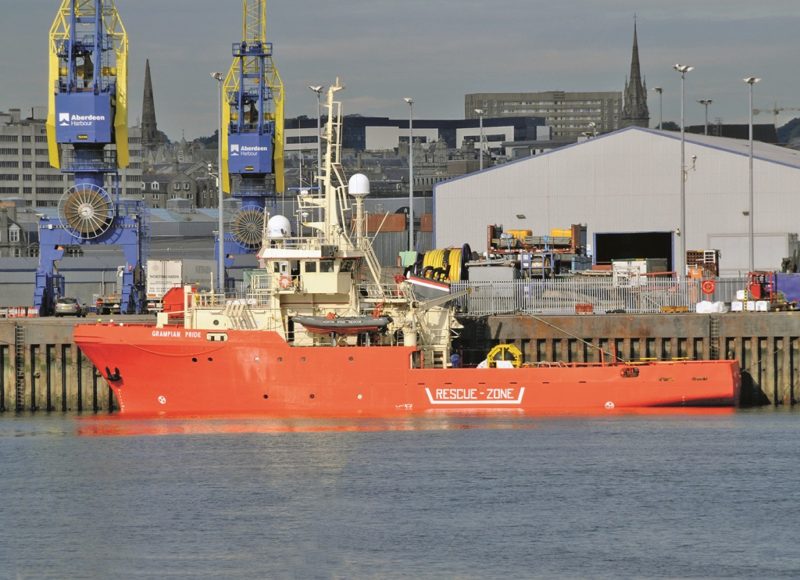
BOSTON PUTFORD OFFSHORE SAFETY Ltd.
This company was incorporated on 23rd June 1948 by Boston Deep Sea Fisheries Ltd., Putford Enterprises Ltd. of Lowestoft, Warbler Fishing Co. Ltd., and the Great Yarmouth ship repairer Breydon Marine. The fleet consisted almost entirely of standby and rescue vessels, which operated all round the U.K. coast in a constant state of readiness in the event of an emergency arising on board oil rigs and requiring the urgent disembarkation of personnel. Many of the vessels were converted trawlers, with a few specially built for purpose ships. The fleet was taken over in December 1987 in a management buy-out in the name of Britannia Marine of Lowestoft, and part of the North British Marine Group of Hull. In 1998, the fleet was acquired by the American supply ship operators Seacor, and in 2020 Boston Putford Offshore Safety Ltd. was taken over by North Star Shipping Ltd. of Aberdeen.
Boston Putford of Lowestoft is now part of the Craig Group portfolio with fourteen emergency response and rescue vessels (ERRV), all equipped with ‘daughter’ craft and fast rescue craft and tasked for deployment in the Southern North Sea. Boston Putford has the current fleet of Putford Achates, Putford Achiever, Putford Ajax, Putford Aries, Putford Defender, Putford Jaguar, Putford Phoenix, Putford Pride, Putford Protector, Putford Provider, Putford Saviour, Putford Terminator, Putford Viking and Putford Voyager.
Matthew Gordon was appointed Chief Executive of North Star Shipping Ltd. on 6th July 2020 to take over from the previous Chief Executive Callum Bruce, who stepped down after 34 years in the offshore standby safety vessel business in the North Sea. He thus was responsible for the new North Star Shipping Ltd. purchase of the Lowestoft company of Boston Putford Ltd., which remains operational from Lowestoft.
OFFSHORE WIND FARM SERVICE OPERATION VESSELS (SOV)
The Operations and Maintenance aspects of Offshore Wind Farms (OWF) vary according to the distance of the OWF from the U.K. coastline. If the OWF is within 12 nautical miles of the coast e.g. the Blyth EDF Offshore Demonstrator OWF only five nautical miles offshore, which uses workboats and passenger launches to show prospective clients the five turbines on the OWF. If the OWF is between 12 and 50 nautical miles from the coast then a combination of workboats and helicopters are used to ferry the turbine technicians to and from the OWF e.g. the Outer Gabbard Wind Farm in the sea area between Harwich and Aldeburgh around 45 to 50 nautical miles from the shore. If a very large OWF with hundreds of wind turbines is well beyond 50 nautical miles from the coast then the turbine maintenance, array cable maintenance, foundation maintenance and export cable connection inspections will be done from a Service Operation Vessel (SOV), which remains at the site for a number of weeks up to one month with enough accommodation for all of the specialist technicians working at the OWF site.
An example of the latter is the new Dogger Bank Wind Farm over 130 kilometres from the North East coast of England with 300 wind turbines in three phases A, B and C and with each phase generating 1.2 gigawatts of electricity. The Operations and Maintenance Base (O. & M.) is being constructed at South Shields on the old John Readhead shipyard of the Port of Tyne. All three phases of the Dogger Bank Wind Farm will be in operation by 2023 with three state of the art SOVs regularly transporting men and materials every two weeks to the OWF.
Turbine technicians are very necessary for the maintenance of all OWFs, with their primary role in the safe and efficient operation of the turbines up to their maximum capability at all times. SCADA (Supervisory Control and Data Acquisition) high level automatic systems monitor the wind farms on a 24/7 basis, but corrective maintenance is often required, in addition to an annual full service of the turbine. Four or five days are spent on oil and filter changes, gearbox and generator alignments during this service.
The Dogger Bank Offshore Wind Farm is owned by Equinor (formerly Statoil of Norway) with 40%, SSE Renewables with 40%, and oil company ENI of Italy with 20%. Phase 3 (the last phase) will be developed on a timescale of 2023/24 and will be owned by Equinor with 50% and SSE Renewables with 50% shares. The contract for the three SOVs to transport technicians and materials from South Shields to the Dogger Bank Offshore Wind Farm was awarded on 6th April 2021 to North Star Renewables, a subsidiary of North Star Shipping (Aberdeen) Co. Ltd. Three SOVs have been designed by VARD Offshore at Skansekaia in Alesund in Norway and are under construction at the VARD Vung Tau shipyard in Vietnam.
The Operations and Maintenance (O. & M.) base at the former John Readhead yard at South Shields of the Port of Tyne has been designed by Ryder Architecture of Newcastle upon Tyne. This is the main operating and maintenance hub of the largest offshore OWF in the world, which is capable of powering six million homes with electricity in the U.K. Some roles are based onshore e.g. planners, engineers and management, while turbine and other technicians are based at the OWF site, living for two weeks at a time on one of the three SOVs over 130 kilometres out in the North Sea. The onshore base consists of a very large warehouse close to and at right angles to a completely rebuilt quay, housing spare parts for the turbines and wind farm, the offices consist of four sections behind the warehouse with different outer wall colours for each section.
The warehouse will have ‘Dogger Bank Wind Farm’ on its River Tyne aspect, and one of the four offices will have ‘Equinor’ on its front aspect. The base will be built using environmentally friendly materials, EV chargers, solar panels and efficient heating systems for IT technicians working on computerised monitoring systems on a three shift basis including at night. The giant 107 metre Haliade-X turbine blades, each producing 12 megawatts, are already being manufactured on Teesside at a new manufacturing facility with the contract awarded earlier in 2021. The turbine blades when at their highest elevation are more than two and a half times as tall as Big Ben at Westminster.
The first SOV will be to the VARD 4 design with an overall length of 85.0 metres, moulded beam of 19.0 metres and will be able to accommodate 78 crew and turbine technicians working at the offshore site. The second and third SOVs will be slightly smaller to the same VARD 4 design with an overall length of 78.0 metres and a moulded beam of 19.0 metres with accommodation for 60 crew and turbine technicians in single cabins while working at the offshore site. The charters from North Star Renewables are for ten years for each SOV, with an option for an extension of a one year charter period for each vessel. All of the trio will have a height adjustable, motion compensated gangway to allow the turbine technicians to ‘walk to work’, plus a height adjustable boat transfer system, as well as a 3D compensated deck crane for cargo transfer. For optimal environmental footprint and operation, a hybrid storage battery system is linked to diesel electric propulsion systems, highly efficient main propellers and tunnel thrusters, with permanent magnet electric motors in combination with energy monitor information from SEAQ solutions supplied by Vard Electro in Norway. Much other equipment will come from suppliers in the Norwegian Maritime Cluster grouping.
The new Voltaire jack up wind turbine installation vessel owned by Jan de Nul of Holland will have her first deployment when she is completed in 2022 on the installation of all turbines in Phases A, B and C of the Dogger Bank Wind Farm. Voltaire will have extremely low emissions with dual exhaust filter systems to remove up to 99% of nano particles from emissions using a diesel particulate filter (DPF) followed by selective Catalytic Reduction Systems for poisonous NOX removal. Voltaire is classed as an Ultra Low Emission Vessel (ULEV) that complies with all regulations for working on offshore sites, land sites and inland waterways.
Design work for the construction of the export cables from the Dogger Bank Offshore Wind Farm (OWF) began ten years ago, with land agreements in place for the onward cables from the OWF export cables landfall at the village of Ulrome in the East Riding of Yorkshire midway between Hornsea and the small port of Bridlington to reach the existing Creyke Beck electricity substation near Cottingham, a northern suburb of Hull. Dogger Bank ‘A’ and ‘B’ sites will use this substation, while Dogger Bank ‘C’ site will connect to the existing Lackenby converter electricity substation on Teesside. The trench excavations for the export cables from landfall to the Creyke Beck substation required years of negotiation to agree to the cable corridor, and then more years in the excavation of the trench. The Dogger Bank ‘C’ site is further out on the Dogger Bank at 196 kilometres from shore. The two land converter stations convert the electricity generated by the wind turbines from HVDC to HVAC current before it passes into the adjacent National Grid substation.
Steve Wilson is the Project Director for the Dogger Bank Wind Farm and is based at South Shields Dogger Bank Wind Farm O. & M. base, as is Steve Myers, SOV Operations Director of North Star Renewables, a subsidiary of North Star Shipping of Aberdeen, who will oversee the fleet of three SOVs based at South Shields. The new trio of SOVs will have tall heavily reinforced bow sections for working for prolonged periods in very rough weather conditions, three decks for accommodation, and a ‘midships sophisticated wheelhouse and chartroom, with radars and communication systems installed on a single broad mast behind the navigating bridge, and a much lower stern section for lowering and retrieving workboats and a ‘daughter’ craft in the event of a rescue situation developing 130 kilometres out in the North Sea. North Star Renewables have collaborated with and developed the designs of SOV since 2013 for long term service on other OWFs at considerable distance from the coastline.
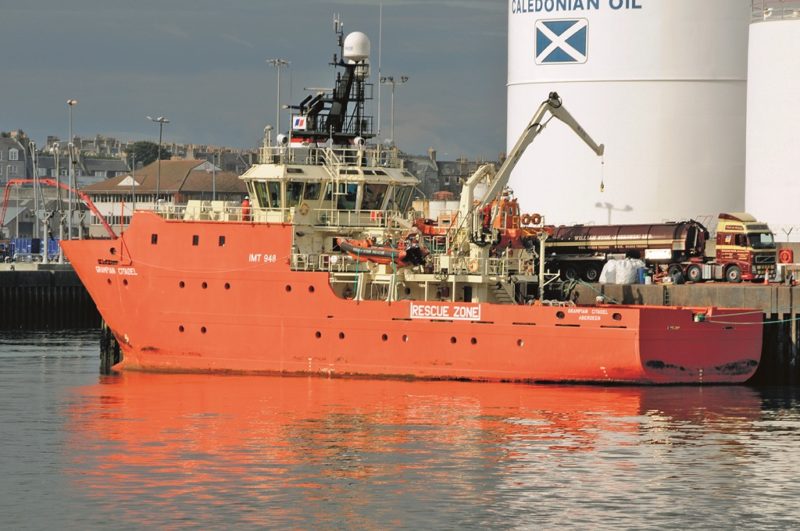
NORTH STAR SHIPPING (ABERDEEN) Co. Ltd.
The company is a member of the Ship Safe Training Group (SSTG), founded over 40 years ago to organise and supervise cadet training programmes for young men interested in a career at sea. The company offers good conditions of service regarding pay, health care, safety and training in all aspects of cadet officer training. Cadets are offered in their first years of service duties on several company ships covering the whole type of operations carried out at sea. Despite this, accidents at sea do happen, as shown by the following incident.
On 28th July 2009, the Emergency Response and Rescue Vessel Grampian Conquest was on offshore standby duty for the oil platform SEDCO 7/11 located in the Bardolino oilfield situated about 190 miles East of Peterhead. The ‘daughter’ rescue craft had been lowered with a crew of three to provide close cover for the platform, whose Offshore Installation Manager (AIM) in charge requested that an oil sample be obtained from the water around the platform as concerns were raised regarding escaping oil and gas. The ‘daughter’ craft regularly carried such sampling but had no sampling kit to hand onboard. Capt. Bruce of Grampian Conquest decided that the ‘daughter’ craft should come alongside his vessel and the sampling kit would be thrown onto the deck of the fast craft. Paul Wilson was a member of the ‘daughter’ craft crew and he thought this kit would be retrieved as usual from the water, so he positioned himself on the rail of the craft and not in the safer stern area. However, when the ‘mother’ ship and ‘daughter’ rescue fast craft came together a collision occurred and Paul Wilson was crushed against the rail of the ‘daughter’ craft. He suffered extensive injuries of five fractured ribs and a fractured clavicle and was off work for over six months without pay. He took his employer to court for compensation for his injuries and loss of earnings, and won his case and was offered £42,941.94 in compensation. The company later changed in 2015 its Action Tracking Management System (ATMS) to improve its tracking and recording of incidents and accidents.
On 6th November 2017, the Craig Group sold North Star Shipping Ltd. to the infrastructure equity investment fund of Basalt Infrastructure Partners for an undisclosed sum. The 31 vessels owned by North Star Shipping Ltd. kept their existing management team, onshore staff and seagoing crews under their new owner. The reason for the sale was to give much larger scope for further investment and growth in areas such as Wind Farm Service Operations Vessels (SOV). North Star Shipping Ltd. continues to operate vessels in the tanker ‘assist’ role, emergency response and rescue role (ERRV), and multi-role ROV, survey, and platform support roles. North Star Shipping Ltd. is the largest offshore support vessel operator in the North Sea, and received a £40 million finance package from the Bank of Scotland in February 2021. North Star Shipping Ltd. currently employs 1,400 personnel in the U.K. working on 31 owned and 13 chartered vessels. Craig Group at Aberdeen continues to own and manage its global oilfield procurement business of Craig International from 12, Queens Road in Aberdeen with nine active directors and a company secretary.
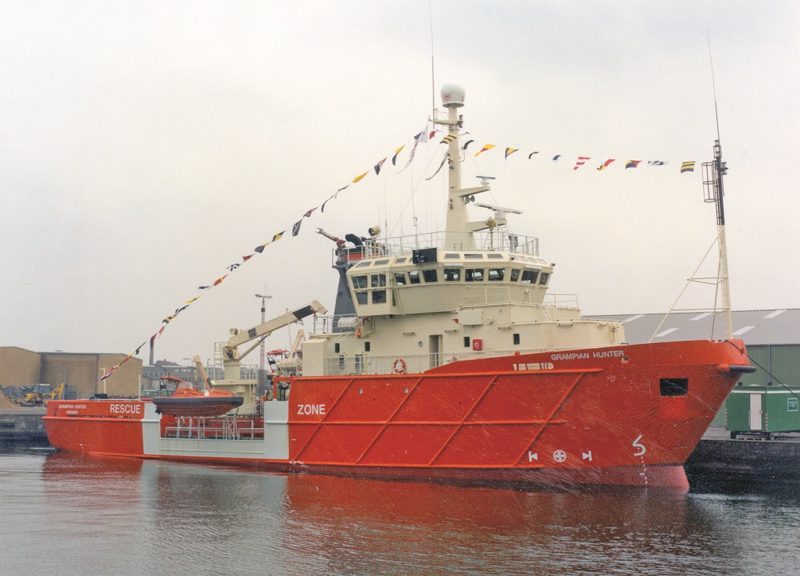
NEW ABERDEEN SOUTH HARBOUR
Construction of a new large South Harbour with four new quays (below) began in June 2017 to ease the congestion of oil related vessels in the overcrowded main harbour. The Bay of Nigg around two miles south of the main harbour and immediately to the south of the coastal Balnagask golf course is the site, with the South Breakwater having reached its final length in July 2021 with the arrival of the last two caissons. The new harbour will have created an Inner Basin of four new quays, named Balmoral Quay, Crathes Quay, Castlegate Quay and Dunnottar Quay (or East Quay). Van Oord of Holland was the principal contractor for the South Breakwater of length 550 metres, while Beattie Construction of Scotland was the contractor for the concrete Crown Wall of height ten metres on top of the North Breakwater to protect the Dunnottar or East Quay from excessive waves.
The total construction cost is £350 million with over £60 million to build the South Breakwater and the Crown Wall on top of the North Breakwater. The remaining costs are to provide the infrastructure of the four quays in the Inner Basin, as well as heavy lift equipment, warehouses and roads. The facts and figures of the new harbour are:-
- Protective Breakwaters of 1.3 km
- Maximum vessel length of 300 m
- Alongside depth in Inner Basin of 15.0 m
- Quay Length of 1,700 m
- Channel Width through the entrance of 165.0 m
- Heavy Lift Capability on quays of 15 tonnes per m2
- Offshore Oil Vessels, Multi-Purpose Ships, Cruise Ships, and Heavy Lift Vessels
Offshore Wind Farms are being built for all of the ‘Big 6’ U.K. energy utilities of British Gas, EDF Energy, EON (U.K.), Npower, SSE, and Scottish Power, while European energy utilities such as DONG, Vattenfall, Statkraft, EDPR, Eneco and Stadtwerke Muenchen are also busy in this green energy sector. Oil companies such as Equinor (formerly Statoil of Norway) and Repsol, supply chain companies such as Siemens and Fluor, and wind turbine manufacturers such as Siemens, Vestas and Repower, Areva, Alstom, Gamesa, Mitsubishi and Samsung are all tendering for their share of this huge and expanding new industry. North Star Shipping made sure that they would obtain their share of this new, expanding business by developing collaborative designs for new SOVs for contract to huge OWFs such as the Dogger Bank Offshore Wind Farm by setting up North Star Renewables some years ago.
The new Hornsea 3 Offshore Wind Farm will be located in deep water a long way distant from the Yorkshire coast and 120 kilometres to the north east of the North Norfolk coastline. This OWF will have 231 wind turbines in a total sea area of 8.8 square kilometres, each turbine generating over 100 megawatts of electricity. The Hornsea 3 OWF site is only just inside the U.K. sector of the North Sea and approximately ten kilometres west of the median line between the U.K. and Dutch sectors of the North Sea. As this big new OWF is very distant from shore, and similar to the Dogger Bank OWF, new sophisticated SOV Operations and Maintenance Vessels will be needed.
The Craig Group and Craig family journey over the last one hundred years have taken them from low technology coal fired, steam powered sidewinder trawlers to powerful oil rig standby ships (ORSS), oil rig supply vessels (ORSV), emergency response and rescue vessels (EERV), and lastly to high technology bespoke Service Operation Vessels (SOV). There are also powerful new tanker escort and ‘assist’ vessels, and multi-role vessels. This is in addition to the global oilfield procurement business.
I wish to sincerely thank the excellent websites of northstarshipping.co.uk, .northstarrenewables.co.uk and craig-international. com for their very clear descriptions and specifications of their operations and vessels.
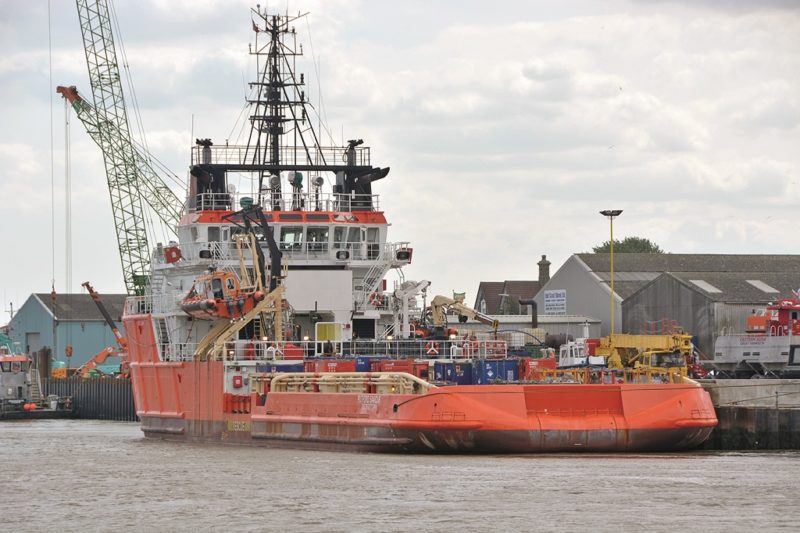

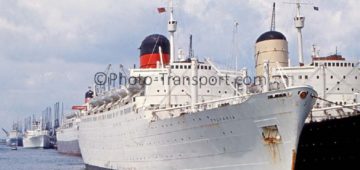


Comments
Sorry, comments are closed for this item